Measurements of Indirect CP Asymmetries in
advertisement
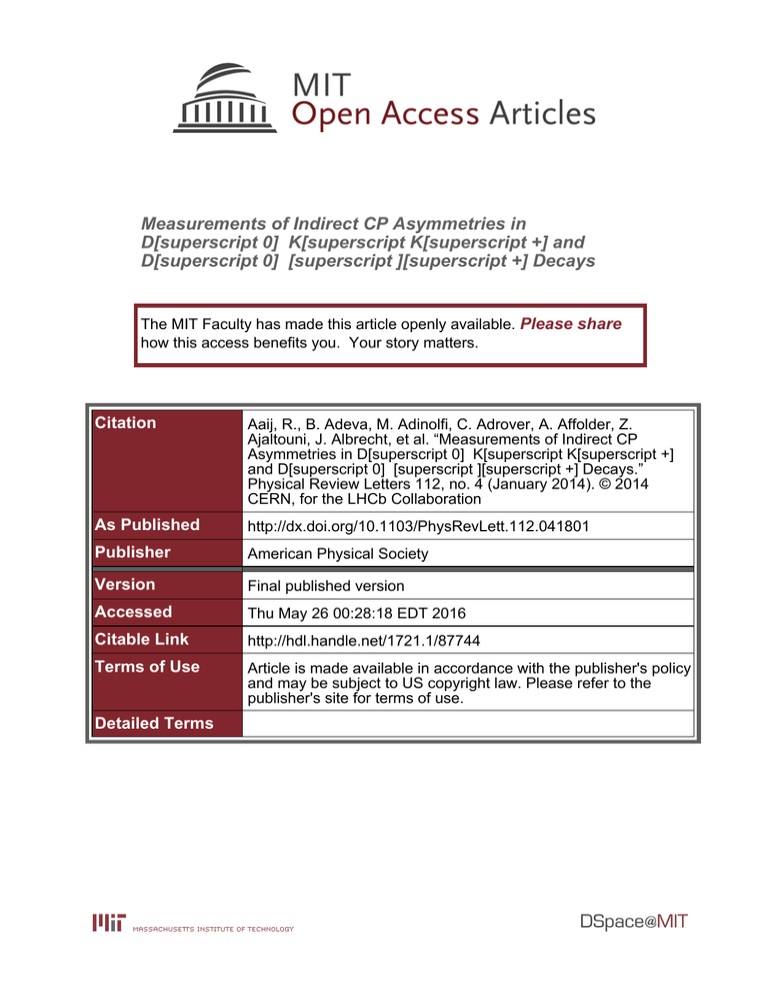
Measurements of Indirect CP Asymmetries in D[superscript 0] K[superscript K[superscript +] and D[superscript 0] [superscript ][superscript +] Decays The MIT Faculty has made this article openly available. Please share how this access benefits you. Your story matters. Citation Aaij, R., B. Adeva, M. Adinolfi, C. Adrover, A. Affolder, Z. Ajaltouni, J. Albrecht, et al. “Measurements of Indirect CP Asymmetries in D[superscript 0] K[superscript K[superscript +] and D[superscript 0] [superscript ][superscript +] Decays.” Physical Review Letters 112, no. 4 (January 2014). © 2014 CERN, for the LHCb Collaboration As Published http://dx.doi.org/10.1103/PhysRevLett.112.041801 Publisher American Physical Society Version Final published version Accessed Thu May 26 00:28:18 EDT 2016 Citable Link http://hdl.handle.net/1721.1/87744 Terms of Use Article is made available in accordance with the publisher's policy and may be subject to US copyright law. Please refer to the publisher's site for terms of use. Detailed Terms PRL 112, 041801 (2014) PHYSICAL REVIEW LETTERS week ending 31 JANUARY 2014 Measurements of Indirect CP Asymmetries in D0 → K − K þ and D0 → π− πþ Decays R. Aaij et al.* (LHCb Collaboration) (Received 29 October 2013; published 31 January 2014) A study of indirect CP violation in D0 mesons through the determination of the parameter AΓ is presented using a data sample of pp collisions, corresponding to an integrated luminosity of 1.0 fb−1 , collected with the LHCb detector and recorded at the center-of-mass energy of 7 TeV at the LHC. The parameter AΓ is the asymmetry of the effective lifetimes measured in decays of D0 and D̄ 0 mesons to the CP eigenstates K − K þ and π − π þ . Fits to the data sample yield AΓ ðKKÞ ¼ ð−0.35 0.62 0.12Þ × 10−3 and AΓ ðππÞ ¼ ð0.33 1.06 0.14Þ × 10−3 , where the first uncertainties are statistical and the second systematic. The results represent the world’s best measurements of these quantities. They show no difference in AΓ between the two final states and no indication of CP violation. DOI: 10.1103/PhysRevLett.112.041801 PACS numbers: 13.25.Ft, 11.30.Er, 12.15.Ff, 14.40.Lb The asymmetry under simultaneous charge and parity transformation (CP violation) has driven the understanding of electroweak interactions since its discovery in the kaon system [1]. CP violation was subsequently discovered in the B0 and B0s systems [2–4]. Charmed mesons form the only neutral meson-antimeson system in which CP violation has yet to be observed unambiguously. This system is the only one in which mesons of up-type quarks participate in matter-antimatter transitions, a loop-level process in the standard model (SM). This charm mixing process has recently been observed for the first time unambiguously in single measurements [5–7]. The theoretical calculation of charm mixing and CP violation is challenging for the charm quark [8–12]. Significant enhancement of mixing or CP violation would be an indication of physics beyond the SM. The mass eigenstates of the neutral charm meson system, jD1;2 i, with masses m1;2 and decay widths Γ1;2 , can be expressed as linear combinations of the flavor eigenstates, jD0 i and jD̄0 i, as jD1;2 i ¼ pjD0 i qjD̄ 0 i with complex coefficients satisfying jpj2 þ jqj2 ¼ 1. This allows the definition of the mixing parameters x ≡ 2ðm2 − m1 Þ=ðΓ1 þ Γ2 Þ and y ≡ ðΓ2 − Γ1 Þ=ðΓ1 þ Γ2 Þ. Nonconservation of CP symmetry enters as a deviation from unity of λf , defined as q Āf qĀf λf ≡ ¼ −ηCP eiϕ ; p Af pAf (1) where Af (Āf ) is the amplitude for a D0 (D̄ 0 ) meson decaying into a CP eigenstate f with eigenvalue ηCP , and ϕ * Full author list given at the end of the article. Published by the American Physical Society under the terms of the Creative Commons Attribution 3.0 License. Further distribution of this work must maintain attribution to the author(s) and the published articles title, journal citation, and DOI. 0031-9007=14=112(4)=041801(9) is the CP-violating relative phase between q=p and Āf =Af . Direct CP violation occurs when the asymmetry Ad ≡ ðjAf j2 − jĀf j2 Þ=ðjAf j2 þ jĀf j2 Þ is different from zero. Indirect CP violation comprises nonzero CP asymmetry in mixing, Am ≡ ðjq=pj2 − jp=qj2 Þ=ðjq=pj2 þ jp=qj2 Þ and CP violation through a nonzero phase φ. The phase convention of φ is chosen such that, in the limit of no CP violation, CPjD0 i ¼ −j D̄0 i. In this convention CP conservation leads to ϕ ¼ 0 and jD1 i being CP odd. The asymmetry of the inverse of effective lifetimes in decays of D0 (D̄ 0 ) mesons into CP-even final states, Γ̂ (Γ̄ˆ ), leads to the observable AΓ defined as Am þ Ad Γ̂ − Γ̄ˆ y cos φ − x sin φ : AΓ ≡ ≈ ηCP 2 Γ̂ þ Γ̄ˆ (2) This makes AΓ a measurement of indirect CP violation, as the contributions from direct CP violation are measured to be small [13] compared to the precision on AΓ available so far [14]. Here, effective lifetimes refer to lifetimes measured using a single-exponential model in a specific decay mode. Currently available measurements of AΓ [15,16] are in agreement with no CP violation at the per mille level [13]. This Letter reports measurements of AΓ in the CP-even final states K − K þ and π − π þ using 1.0 fb−1 of pp collisions at 7 TeV center-of-mass energy at the LHC recorded with the LHCb detector in 2011. In the SM, the phase ϕ is final-state independent and thus measurements in the two final states are expected to yield the same results. At the level of precision of the measurements presented here, differences due to direct CP violation are negligible. However, contributions to ϕ from physics beyond the SM may lead to different results. Even small final-state differences in the phase Δϕ can lead to measurable effects in the observables of the order of xΔϕ, for sufficiently small phases ϕ in both final states [17]. In addition, the 041801-1 © 2014 CERN, for the LHCb Collaboration PRL 112, 041801 (2014) PHYSICAL REVIEW LETTERS measurements of AΓ in both final states are important to quantify the contribution of indirect CP violation to the observable ΔACP , which measures the difference in decaytime integrated CP asymmetry of D0 → K − K þ to π − π þ decays [18,19]. The LHCb detector [20] is a single-arm forward spectrometer covering the pseudorapidity range 2 < η < 5, designed for the study of particles containing b or c quarks. The spectrometer dipole magnet is operated in either one of two polarities, the magnetic field vector points either up or down. The trigger [21] consists of a hardware stage, based on information from the calorimeter and muon systems, followed by a software stage, which performs a full event reconstruction. The software trigger applies two sequential selections. The first selection requires at least one track to have momentum transverse to the beam line pT , greater than 1.7 GeV=c and an impact parameter χ 2, χ 2IP , greater than 16. The χ 2IP is defined as the difference in χ 2 of a given primary interaction vertex reconstructed with and without the considered track. This χ 2IP requirement introduces the largest effect on the observed decay-time distribution compared to other selection criteria. In the second selection this track is combined with a second track to form a candidate for a D0 decay into two hadrons (charge conjugate states are included unless stated otherwise). The second track must have pT > 0.8 GeV=c and χ 2IP > 2. The decay vertex is required to have a flight distance χ 2 per degree of freedom greater than 25 and the D0 invariant mass, assuming kaons or pions as final state particles, has to lie within 50 MeV=c2 (or within 120 MeV=c2 for a trigger whose rate is scaled down by a factor of 10) around 1865 MeV=c2 . The momentum vector of the two-body system is required to point back to the pp interaction region. The event selection applies a set of criteria that are closely aligned to those applied at the trigger stage. The final-state particles have to match particle identification criteria to separate kaons from pions [22] according to their mass hypothesis and must not be identified as muons using combined information from the tracking and particle identification systems. Flavor tagging is performed through the measurement of the charge of the pion in the decay Dþ → D0 π þ (soft pion). Additional criteria are applied to the track quality of the soft pion as well as to the vertex quality of the Dþ meson. Using a fit constraining the soft pion to the pp interaction vertex, the invariant mass difference of the Dþ and D0 candidates Δm is required to be less than 152 MeV=c2 . About 10% of the selected events have more than one candidate passing the selections, mostly due to one D0 candidate being associated with several soft pions. One candidate per event is selected at random to reduce the background from randomly associated soft pions. The D0 decay-time range is restricted to 0.25 to 10 ps such that week ending 31 JANUARY 2014 there are sufficient amounts of data in all decay-time regions included in the fit to ensure its stability. The whole data set is split into four subsets, identified by the magnet polarity, and two separate data-taking periods to account for known differences in the detector alignment and calibration. The smallest subset contains about 20% of the total data sample. Results of the four subsets are combined in a weighted average. The selected events contain about 3.11 × 106 D0 → − þ K K and 1.03 × 106 D0 → π − π þ signal candidates, where the Dþ meson is produced at the pp-interaction vertex, with purities of 93.6% and 91.2%, respectively, as measured in a region of 2 standard deviations of the signal peaks in D0 mass, mðhhÞ (with h ¼ K, π), and Δm. The effective lifetimes are extracted by eight independent multivariate unbinned maximum likelihood fits to the four subsamples, separated by the D0 flavor as determined by the charge of the soft pion. The fits are carried out in two stages, a fit to mðhhÞ and Δm to extract the signal yield and a fit to the decay time and lnðχ 2IP Þ of the D0 candidate to extract the effective lifetime. The first stage is used to distinguish the following candidate classes: correctly tagged signal candidates, which peak in both variables; correctly reconstructed D0 candidates associated with a random soft pion (labeled “rnd. π s” in the figures), which peak in mðhhÞ but follow a threshold function in Δm ; and combinatorial background. pffiffiffiffiffiffiffiffiffiffiffiffiffiffiffiffiffiffiffiffiffiThe threshold functions are polynomials in Δm − mπþ . The signal peaks in mðhhÞ and Δm are described by the sum of three Gaussian functions. For the π − π þ final state a power-law tail is added to the mðhhÞ distribution to describe the radiative tail [23]. The combinatorial background is described by an exponential function in mðhhÞ and a threshold function in Δm. Partially reconstructed decays constitute additional background sources. The channels that give significant contributions are the decays D0 → K − π þ π 0 , with the charged pion reconstructed as a kaon and the π 0 meson not − þ þ reconstructed, and Dþ s → K K π , with the pion not reconstructed. The former peaks broadly in Δm while the latter follows a threshold function and both are described by an exponential in mðhhÞ. Reflections due to incorrect mass assignment of the tracks are well separated in mass and are suppressed by particle identification and are not taken into account. An example fit projection is shown in Fig. 1. Charm mesons originating from long-lived b hadrons (secondary candidates) form a large background that cannot be separated in the mass fit. They do not come from the interaction point leading to a biased decay-time measurement. The flight distance of the b hadrons causes the D0 candidates into which they decay to have large χ 2IP on average. This is therefore used as a separating variable. Candidates for signal decays, where the Dþ is produced at the pp-interaction vertex, are modeled by an exponential 041801-2 PRL 112, 041801 (2014) Data Fit Signal Rnd. πs 0 D0+→K-+π+π Ds →K K π+ Comb. bkg LHCb 104 3 10 102 140 145 102 10 1 150 ∆m [MeV/c2] Pull 5 FIG. 1 (color online). Fit of Δm for one of the eight subsets, containing the D̄ 0 → K − K þ candidates with magnet polarity down for the earlier run period. 0 -5 2 n(D )/n(D0) 1.2 1.1 x≤μ x > μ; (3) where all parameters are allowed to have a linear variation with decay time. The parameters α and β describe the left and right width of the distribution, respectively, and μ is the peak position. Secondary candidates are described by the convolution of two exponential probability density functions in decay time. Since there can be several sources of secondary candidates, the sum of two such convolutions is used with one of the decay constants shared, apart from the smaller π − π þ data set where a single convolution is sufficient to describe the data. The lnðχ 2IP Þ distribution of secondary decays is also given by Eq. (3); however, the three parameters are replaced by functions of decay time αðtÞ ¼ A þ Bt þ C arctanðDtÞ; (4) and similarly for β and μ, where the parametrizations are motivated by studies on highly enriched samples of secondary decays and where A, B, C, and D describe the decay-time dependence. The background from correctly reconstructed D0 mesons associated to a random soft pion share the same lnðχ 2IP Þ shape as the signal. Other combinatorial backgrounds and partially reconstructed decays for the K − K þ final state are described by nonparametric distributions. The shapes are obtained by applying an unfolding technique described in Ref. [24] to the result of the mðhhÞ, Δm fit. Gaussian kernel density estimators are applied to create smooth distributions [25]. The detector resolution is accounted for by the convolution of a Gaussian function with the decay-time function. The Gaussian width is 50 fs, an effective value extracted from studies of B → J=ψX decays [26], which has negligible 1.2 0 αðx−μÞ eαx−e βðx−μÞ eαμþβðx−μÞ−e 4 t [ps] 6 Data Fit Prompt signal 1 0.9 0.8 n(D )/n(D0) fðxÞ ≡ 0 function in decay time, whose decay constant determines the effective lifetime, and by a modified χ 2 function in lnðχ 2IP Þ of the form n Data Fit Signal Secondary Prompt rnd. πs Sec. rnd. πs D0+→K +π+π- 0 Ds →K K π+ Comb. bkg LHCb 103 Entries / (0.02 ps) Entries / (0.02 MeV/c2) 104 week ending 31 JANUARY 2014 PHYSICAL REVIEW LETTERS 1.1 LHCb 1 2 t [ps] 3 2 3 Data Fit Prompt signal 1 0.9 0.8 LHCb 1 t [ps] FIG. 2 (color online). Top: fit of decay time to D̄ 0 → K − K þ and corresponding pull plot for candidates with magnet polarity down for the earlier run period, where pull is defined as ðdata − modelÞ=uncertainty. Middle and bottom: the ratio of D̄ 0 to D0 data and fit model for decays to K − K þ and π − π þ for all data, respectively. effect on the measurement. Biases introduced by the selection criteria are accounted for through per-candidate acceptance functions which are determined in a data-driven way. The acceptance functions, which take values of 1 for all decaytime intervals in which the candidate would have been accepted and 0 otherwise, enter the fit in the normalization of the decay-time parametrizations. The procedure for determination and application of these functions is described in detail in Refs. [15,27]. Additional geometric detector acceptance effects are also included in the procedure. An example decay-time fit projection is shown in Fig. 2. The fit yields AΓ ðKKÞ¼ð−0.350.62Þ×10−3 and AΓ ðππÞ ¼ ð0.33 1.06Þ × 10−3 , with statistical uncertainties only. The results of the four subsets are found to be in agreement with each other. The fit has regions where the model fails to describe the data accurately, particularly at small decay times and intermediate values of lnðχ 2IP Þ as shown in the pull plot in Fig. 2. The same deviations are observed in 041801-3 600 400 800 600 400 700 600 500 400 LHCb 300 200 200 200 Data Fit Signal Secondary Prompt rnd. πS Sec. rnd. πS 0 D0→ K-π+π D+s→ K+K-π+ Comb. bkg. 800 LHCb Entries / 0.14 800 Data Fit Signal Secondary Prompt rnd. πS Sec. rnd. πS 0 D0→ K-π+π D+s→ K+K-π+ Comb. bkg. LHCb Entries / 0.14 Entries / 0.14 1000 Data Fit Signal Secondary Prompt rnd. πS Sec. rnd. πS 0 D0→ K-π+π D+s→ K+K-π+ Comb. bkg. 1000 week ending 31 JANUARY 2014 PHYSICAL REVIEW LETTERS PRL 112, 041801 (2014) 100 0 -5 FIG. 3 (color online). 1.55–1.80 ps. 0 ln(χ2IP) 5 0 -5 0 ln(χ2IP) 5 0 -5 0 ln(χ2IP) 5 Fits of lnðχ 2IP Þ for D̄ 0 → K − K þ candidates for decay-time bins (left to right) 0.25–0.37 ps, 0.74–0.78 ps, and pseudoexperiment studies, and are reproduced in several independent parametrizations, indicating that the origin is related to the nonparametric treatment of backgrounds in connection with nonideal parametrizations of the lnðχ 2IP Þ distributions. They do not significantly affect the central value of AΓ due to the low correlations between the effective lifetime and other fit parameters. The deviations are very similar for fits to D0 and D̄ 0 samples leading to their cancellations in the final asymmetry calculations as shown in Fig. 2. In addition to the nominal procedure, an alternative method is used, in which the data are binned in equally populated regions of the decay-time distribution and the ratio of D̄0 to D0 yields calculated in each bin. This avoids the need to model the decay-time acceptance. The time dependence of this ratio R allows the calculation of AΓ from a simple linear χ 2 minimization, with N D̄0 2AΓ 1 − e−Δt=τD̄0 1þ t ; RðtÞ ≈ N D0 τKK 1 − e−Δt=τD0 (5) where τKK ¼ τKπ =ð1 þ yCP Þ is used as an external input based on current world averages [13,28], N D̄0 =N D0 is the signal yield ratio integrated over all decay times and Δt is the bin width. The dependence on τD0 and τD̄0 cancels in the extraction of AΓ . For this method the signal yields for decays, where the Dþ is produced at the pp-interaction vertex, for each decay-time bin are extracted by simultaneous unbinned maximum likelihood fits to mðhhÞ, Δm, and lnðχ 2IP Þ. Each bin is chosen to contain about 4 × 104 candidates, leading to 118 and 40 bins for K − K þ and π − π þ , respectively. In general, the binned fit uses similar parametrizations to the unbinned fit, though a few simplifications are required to account for the smaller sample size per bin. The evolution of the fit projections in lnðχ 2IP Þ with decay time is shown in Fig. 3. The fits for both methods are verified by randomizing the flavor tags and checking that the results for AΓ are in agreement with zero. Similarly, the measurement techniques for AΓ are applied to the Cabibbo-favored K − π þ final state for which they also yield results in agreement with zero. The unbinned fit is further checked by comparing the extracted lifetime using the K − π þ final state to the world average D0 lifetime, ð410:1 1.5Þ fs [28]. The result of ð412:88 0.08Þ fs, where the uncertainty is only statistical, is found to be in reasonable agreement. If the full difference to the world average were taken as a relative systematic bias it would lead to an absolute bias of less than 10−4 on AΓ . Large numbers of pseudoexperiments, with both zero and nonzero input values for AΓ, are used to confirm the accuracy of the results and their uncertainties. Finally, dependencies on D0 kinematics and flight direction, the selection at the hardware trigger stage, and the track and vertex multiplicity, are found to be negligible. The binned fit yields AΓ ðKKÞ ¼ ð0.50 0.65Þ × 10−3 and AΓ ðππÞ ¼ ð0.85 1.22Þ × 10−3 . Considering the statistical variation between the two methods and the uncorrelated systematic uncertainties, the results from both methods yield consistent results. The systematic uncertainties assessed are summarized in Table I. The effect of shortcomings in the description TABLE I. Systematic uncertainties, given as multiples of 10−3 . The first column for each final state refers to the unbinned fit method and the second column to the binned fit method. Source Partially reconstructed backgrounds Charm from b decays Other backgrounds Acceptance function Magnet polarity Total systematic uncertainty Aunb Γ ðKKÞ Abin Γ ðKKÞ Aunb Γ ðππÞ Abin Γ ðππÞ 0.02 0.07 0.02 0.09 0.12 0.09 0.55 0.40 0.58 0.89 0.00 0.07 0.04 0.11 0.14 0.00 0.53 0.57 0.82 1.13 041801-4 PRL 112, 041801 (2014) PHYSICAL REVIEW LETTERS of the partially reconstructed background component in the K − K þ final state is estimated by fixing the respective distributions to those obtained in fits to simulated data. The imperfect knowledge of the length scale of the vertex detector as well as decay-time resolution effects are found to be negligible. Potential inaccuracies in the description of the combinatorial background and background from signal candidates originating from b-hadron decays are assessed through pseudoexperiments with varied background levels and varied generated distributions, while leaving the fit model unchanged. The impact of imperfect treatment of background from D0 candidates associated to random soft pions is evaluated by testing several fit configurations with fewer assumptions on the shape of this background. The accuracy of the decay-time acceptance correction in the unbinned fit method is assessed by testing the sensitivity to artificial biases applied to the per-event acceptance functions. The overall systematic uncertainties of the two final states for the unbinned method have a correlation of 0.31. A significant difference between results for the two magnet polarities is observed in the binned method. As this cannot be guaranteed to cancel, a systematic uncertainty is assigned. The unbinned method is not affected by this as it is not sensitive to the overall normalization of the D0 and D̄ 0 samples. In general, the two methods are subject to different sets of systematic effects due to the different ways in which they extract the results. The systematic uncertainties for the binned method are larger due to the fact that the fits are performed independently in each decaytime bin. This can lead to instabilities in the behavior of particular fit components with time, an effect which is minimized in the unbinned fit. The effects of such instabilities are determined by running simulated pseudoexperiments. The use of the external input for τKK in the binned fit method does not yield a significant systematic uncertainty. A potential bias in this method due to inaccurate parametrizations of other backgrounds is tested by replacing the probability density functions by different models and a corresponding systematic uncertainty is assigned. In summary, the CP-violating observable AΓ is measured using the decays of neutral charm mesons into K − K þ and π − π þ . The results of AΓ ðKKÞ ¼ ð−0.35 0.62 0.12Þ × 10−3 and AΓ ðππÞ ¼ ð0.33 1.06 0.14Þ × 10−3 , where the first uncertainties are statistical and the second are systematic, represent the world’s best measurements of these quantities. The result for the K − K þ final state is obtained based on an independent data set to the previous LHCb measurement [15], with which it agrees well. The results show no significant difference between the two final states and both results are in agreement with zero, thus indicating the absence of indirect CP violation at this level of precision. week ending 31 JANUARY 2014 We express our gratitude to our colleagues in the CERN accelerator departments for the excellent performance of the LHC. We thank the technical and administrative staff at the LHCb institutes. We acknowledge support from CERN and from the national agencies: CAPES, CNPq, FAPERJ, and FINEP (Brazil); NSFC (China); CNRS/IN2P3 and Region Auvergne (France); BMBF, DFG, HGF, and MPG (Germany); SFI (Ireland); INFN (Italy); FOM and NWO (Netherlands); SCSR (Poland); MEN/IFA (Romania); MinES, Rosatom, RFBR, and NRC “Kurchatov Institute” (Russia); MinECo, XuntaGal, and GENCAT (Spain); SNSF and SER (Switzerland); NAS Ukraine (Ukraine); STFC (United Kingdom); NSF (USA). We also acknowledge the support received from the ERC under FP7. The Tier1 computing centers are supported by IN2P3 (France), KIT, and BMBF (Germany), INFN (Italy), NWO, and SURF (Netherlands), PIC (Spain), and GridPP (United Kingdom). We are thankful for the computing resources put at our disposal by Yandex LLC (Russia), as well as to the communities behind the multiple open source software packages on which we depend. [1] J. Christenson, J. Cronin, V. Fitch, and R. Turlay, Phys. Rev. Lett. 13, 138 (1964). [2] B. Aubert et al. (BABAR Collaboration), Phys. Rev. Lett. 87, 091801 (2001). [3] K. Abe et al. (Belle Collaboration), Phys. Rev. Lett. 87, 091802 (2001). [4] R. Aaij et al. (LHCb Collaboration), Phys. Rev. Lett. 110, 221601 (2013). [5] R. Aaij et al. (LHCb Collaboration), Phys. Rev. Lett. 110, 101802 (2013). [6] T. A. Aaltonen et al. (CDF Collaboration), Phys. Rev. Lett. 111, 231802 (2013). [7] R. Aaij et al. (LHCb Collaboration), Phys. Rev. Lett. 111, 251801 (2013). [8] M. Bobrowski, A. Lenz, J. Riedl, and J. Rohrwild, J. High Energy Phys. 03 (2010) 009. [9] H. Georgi, Phys. Lett. B 297, 353 (1992). [10] T. Ohl, G. Ricciardi, and E. H. Simmons, Nucl. Phys. B403, 605 (1993). [11] I. I. Bigi and N. G. Uraltsev, Nucl. Phys. B592, 92 (2000). [12] A. Lenz and T. Rauh, Phys. Rev. D 88, 034004 (2013). [13] Y. Amhis et al. (Heavy Flavor Averaging Group) arXiv:1207.1158; updated results and plots available at http://www.slac.stanford.edu/xorg/hfag/. [14] M. Gersabeck, M. Alexander, S. Borghi, V. V. Gligorov, and C. Parkes, J. Phys. G 39, 045005 (2012). [15] R. Aaij et al. (LHCb Collaboration), J. High Energy Phys. 04 (2012) 129. [16] J. P. Lees et al. (BABAR Collaboration), Phys. Rev. D 87, 012004 (2013). [17] A. L. Kagan and M. D. Sokoloff, Phys. Rev. D 80, 076008 (2009). [18] R. Aaij et al. (LHCb Collaboration), Phys. Rev. Lett. 108, 111602 (2012). 041801-5 PRL 112, 041801 (2014) PHYSICAL REVIEW LETTERS [19] R. Aaij et al. (LHCb Collaboration), Phys. Lett. B 723, 33 (2013). [20] A. A. Alves, Jr. et al. (LHCb Collaboration), JINST 3, S08005 (2008). [21] R. Aaij et al., JINST 8, P04022 (2013). [22] M. Adinolfi et al., Eur. Phys. J. C 73, 2431 (2013). [23] T. Skwarnicki, Ph.D. thesis, Institute of Nuclear Physics, Krakow, 1986, DESY-F31-86-02. [24] M. Pivk and F. R. Le Diberder, Nucl. Instrum. Methods Phys. Res., Sect. A 555, 356 (2005). week ending 31 JANUARY 2014 [25] D. Scott, Multivariate Density Estimation: Theory, Practice, and Visualization (John Wiley and Sons, New York, 1992). [26] R. Aaij et al. (LHCb Collaboration), Phys. Rev. Lett. 108, 101803 (2012). [27] V. V. Gligorov, R. Aaij, M. Cattaneo, M. Clemencic, M. Gersabeck, A. Falabella, E Van Herwijnen, N. Torr, G. Raven, and F. Stagni, J. Phys. Conf. Ser. 396, 022016 (2012). [28] J. Beringer et al. (Particle Data Group), Phys. Rev. D 86, 010001 (2012), and 2013 partial update for the 2014 edition. R. Aaij,40 B. Adeva,36 M. Adinolfi,45 C. Adrover,6 A. Affolder,51 Z. Ajaltouni,5 J. Albrecht,9 F. Alessio,37 M. Alexander,50 S. Ali,40 G. Alkhazov,29 P. Alvarez Cartelle,36 A. A. Alves Jr.,24 S. Amato,2 S. Amerio,21 Y. Amhis,7 L. Anderlini,17,a J. Anderson,39 R. Andreassen,56 J. E. Andrews,57 R. B. Appleby,53 O. Aquines Gutierrez,10 F. Archilli,18 A. Artamonov,34 M. Artuso,58 E. Aslanides,6 G. Auriemma,24,b M. Baalouch,5 S. Bachmann,11 J. J. Back,47 A. Badalov,35 C. Baesso,59 V. Balagura,30 W. Baldini,16 R. J. Barlow,53 C. Barschel,37 S. Barsuk,7 W. Barter,46 T. Bauer,40 A. Bay,38 J. Beddow,50 F. Bedeschi,22 I. Bediaga,1 S. Belogurov,30 K. Belous,34 I. Belyaev,30 E. Ben-Haim,8 G. Bencivenni,18 S. Benson,49 J. Benton,45 A. Berezhnoy,31 R. Bernet,39 M.-O. Bettler,46 M. van Beuzekom,40 A. Bien,11 S. Bifani,44 T. Bird,53 A. Bizzeti,17,c P. M. Bjørnstad,53 T. Blake,37 F. Blanc,38 J. Blouw,10 S. Blusk,58 V. Bocci,24 A. Bondar,33 N. Bondar,29 W. Bonivento,15 S. Borghi,53 A. Borgia,58 T. J. V. Bowcock,51 E. Bowen,39 C. Bozzi,16 T. Brambach,9 J. van den Brand,41 J. Bressieux,38 D. Brett,53 M. Britsch,10 T. Britton,58 N. H. Brook,45 H. Brown,51 A. Bursche,39 G. Busetto,21,d J. Buytaert,37 S. Cadeddu,15 O. Callot,7 M. Calvi,20,e M. Calvo Gomez,35,f A. Camboni,35 P. Campana,18,37 D. Campora Perez,37 A. Carbone,14,g G. Carboni,23,h R. Cardinale,19,i A. Cardini,15 H. Carranza-Mejia,49 L. Carson,52 K. Carvalho Akiba,2 G. Casse,51 L. Castillo Garcia,37 M. Cattaneo,37 C. Cauet,9 R. Cenci,57 M. Charles,54 P. Charpentier,37 S.-F. Cheung,54 N. Chiapolini,39 M. Chrzaszcz,39,25 K. Ciba,37 X. Cid Vidal,37 G. Ciezarek,52 P. E. L. Clarke,49 M. Clemencic,37 H. V. Cliff,46 J. Closier,37 C. Coca,28 V. Coco,40 J. Cogan,6 E. Cogneras,5 P. Collins,37 A. Comerma-Montells,35 A. Contu,15,37 A. Cook,45 M. Coombes,45 S. Coquereau,8 G. Corti,37 B. Couturier,37 G. A. Cowan,49 D. C. Craik,47 M. Cruz Torres,59 S. Cunliffe,52 R. Currie,49 C. D’Ambrosio,37 P. David,8 P. N. Y. David,40 A. Davis,56 I. De Bonis,4 K. De Bruyn,40 S. De Capua,53 M. De Cian,11 J. M. De Miranda,1 L. De Paula,2 W. De Silva,56 P. De Simone,18 D. Decamp,4 M. Deckenhoff,9 L. Del Buono,8 N. Déléage,4 D. Derkach,54 O. Deschamps,5 F. Dettori,41 A. Di Canto,11 H. Dijkstra,37 M. Dogaru,28 S. Donleavy,51 F. Dordei,11 A. Dosil Suárez,36 D. Dossett,47 A. Dovbnya,42 F. Dupertuis,38 P. Durante,37 R. Dzhelyadin,34 A. Dziurda,25 A. Dzyuba,29 S. Easo,48 U. Egede,52 V. Egorychev,30 S. Eidelman,33 D. van Eijk,40 S. Eisenhardt,49 U. Eitschberger,9 R. Ekelhof,9 L. Eklund,50,37 I. El Rifai,5 C. Elsasser,39 A. Falabella,14,j C. Färber,11 C. Farinelli,40 S. Farry,51 D. Ferguson,49 V. Fernandez Albor,36 F. Ferreira Rodrigues,1 M. Ferro-Luzzi,37 S. Filippov,32 M. Fiore,16,j C. Fitzpatrick,37 M. Fontana,10 F. Fontanelli,19,i R. Forty,37 O. Francisco,2 M. Frank,37 C. Frei,37 M. Frosini,17,37,a E. Furfaro,23,h A. Gallas Torreira,36 D. Galli,14,g M. Gandelman,2 P. Gandini,58 Y. Gao,3 J. Garofoli,58 P. Garosi,53 J. Garra Tico,46 L. Garrido,35 C. Gaspar,37 R. Gauld,54 E. Gersabeck,11 M. Gersabeck,53 T. Gershon,47 P. Ghez,4 V. Gibson,46 L. Giubega,28 V. V. Gligorov,37 C. Göbel,59 D. Golubkov,30 A. Golutvin,52,30,37 A. Gomes,2 P. Gorbounov,30,37 H. Gordon,37 M. Grabalosa Gándara,5 R. Graciani Diaz,35 L. A. Granado Cardoso,37 E. Graugés,35 G. Graziani,17 A. Grecu,28 E. Greening,54 S. Gregson,46 P. Griffith,44 L. Grillo,11 O. Grünberg,60 B. Gui,58 E. Gushchin,32 Y. Guz,34,37 T. Gys,37 C. Hadjivasiliou,58 G. Haefeli,38 C. Haen,37 S. C. Haines,46 S. Hall,52 B. Hamilton,57 T. Hampson,45 S. Hansmann-Menzemer,11 N. Harnew,54 S. T. Harnew,45 J. Harrison,53 T. Hartmann,60 J. He,37 T. Head,37 V. Heijne,40 K. Hennessy,51 P. Henrard,5 J. A. Hernando Morata,36 E. van Herwijnen,37 M. Heß,60 A. Hicheur,1 E. Hicks,51 D. Hill,54 M. Hoballah,5 C. Hombach,53 W. Hulsbergen,40 P. Hunt,54 T. Huse,51 N. Hussain,54 D. Hutchcroft,51 D. Hynds,50 V. Iakovenko,43 M. Idzik,26 P. Ilten,12 R. Jacobsson,37 A. Jaeger,11 E. Jans,40 P. Jaton,38 A. Jawahery,57 F. Jing,3 M. John,54 D. Johnson,54 C. R. Jones,46 C. Joram,37 B. Jost,37 M. Kaballo,9 S. Kandybei,42 W. Kanso,6 M. Karacson,37 T. M. Karbach,37 I. R. Kenyon,44 T. Ketel,41 B. Khanji,20 O. Kochebina,7 I. Komarov,38 R. F. Koopman,41 P. Koppenburg,40 M. Korolev,31 A. Kozlinskiy,40 L. Kravchuk,32 K. Kreplin,11 M. Kreps,47 G. Krocker,11 P. Krokovny,33 F. Kruse,9 M. Kucharczyk,20,25,37,e V. Kudryavtsev,33 K. Kurek,27 T. Kvaratskheliya,30,37 V. N. La Thi,38 D. Lacarrere,37 G. Lafferty,53 A. Lai,15 D. Lambert,49 R. W. Lambert,41 E. Lanciotti,37 G. Lanfranchi,18 C. Langenbruch,37 T. Latham,47 C. Lazzeroni,44 R. Le Gac,6 J. van Leerdam,40 J.-P. Lees,4 R. Lefèvre,5 A. Leflat,31 J. Lefrançois,7 S. Leo,22 O. Leroy,6 T. Lesiak,25 B. Leverington,11 Y. Li,3 L. Li Gioi,5 M. Liles,51 R. Lindner,37 C. Linn,11 B. Liu,3 G. Liu,37 S. Lohn,37 I. Longstaff,50 J. H. Lopes,2 N. Lopez-March,38 H. Lu,3 D. Lucchesi,21,d J. Luisier,38 H. Luo,49 O. Lupton,54 F. Machefert,7 I. V. Machikhiliyan,30 F. Maciuc,28 O. Maev,29,37 S. Malde,54 G. Manca,15,k G. Mancinelli,6 041801-6 PRL 112, 041801 (2014) PHYSICAL REVIEW LETTERS week ending 31 JANUARY 2014 J. Maratas,5 U. Marconi,14 P. Marino,22,l R. Märki,38 J. Marks,11 G. Martellotti,24 A. Martens,8 A. Martín Sánchez,7 M. Martinelli,40 D. Martinez Santos,41,37 D. Martins Tostes,2 A. Martynov,31 A. Massafferri,1 R. Matev,37 Z. Mathe,37 C. Matteuzzi,20 E. Maurice,6 A. Mazurov,16,37,j J. McCarthy,44 A. McNab,53 R. McNulty,12 B. McSkelly,51 B. Meadows,56,54 F. Meier,9 M. Meissner,11 M. Merk,40 D. A. Milanes,8 M.-N. Minard,4 J. Molina Rodriguez,59 S. Monteil,5 D. Moran,53 P. Morawski,25 A. Mordà,6 M. J. Morello,22,l R. Mountain,58 I. Mous,40 F. Muheim,49 K. Müller,39 R. Muresan,28 B. Muryn,26 B. Muster,38 P. Naik,45 T. Nakada,38 R. Nandakumar,48 I. Nasteva,1 M. Needham,49 S. Neubert,37 N. Neufeld,37 A. D. Nguyen,38 T. D. Nguyen,38 C. Nguyen-Mau,38,m M. Nicol,7 V. Niess,5 R. Niet,9 N. Nikitin,31 T. Nikodem,11 A. Nomerotski,54 A. Novoselov,34 A. Oblakowska-Mucha,26 V. Obraztsov,34 S. Oggero,40 S. Ogilvy,50 O. Okhrimenko,43 R. Oldeman,15,k M. Orlandea,28 J. M. Otalora Goicochea,2 P. Owen,52 A. Oyanguren,35 B. K. Pal,58 A. Palano,13,n M. Palutan,18 J. Panman,37 A. Papanestis,48 M. Pappagallo,50 C. Parkes,53 C. J. Parkinson,52 G. Passaleva,17 G. D. Patel,51 M. Patel,52 G. N. Patrick,48 C. Patrignani,19,i C. Pavel-Nicorescu,28 A. Pazos Alvarez,36 A. Pearce,53 A. Pellegrino,40 G. Penso,24,o M. Pepe Altarelli,37 S. Perazzini,14,g E. Perez Trigo,36 A. Pérez-Calero Yzquierdo,35 P. Perret,5 M. PerrinTerrin,6 L. Pescatore,44 E. Pesen,61 G. Pessina,20 K. Petridis,52 A. Petrolini,19,i A. Phan,58 E. Picatoste Olloqui,35 B. Pietrzyk,4 T. Pilař,47 D. Pinci,24 S. Playfer,49 M. Plo Casasus,36 F. Polci,8 G. Polok,25 A. Poluektov,47,33 E. Polycarpo,2 A. Popov,34 D. Popov,10 B. Popovici,28 C. Potterat,35 A. Powell,54 J. Prisciandaro,38 A. Pritchard,51 C. Prouve,7 V. Pugatch,43 A. Puig Navarro,38 G. Punzi,22,p W. Qian,4 B. Rachwal,25 J. H. Rademacker,45 B. Rakotomiaramanana,38 M. S. Rangel,2 I. Raniuk,42 N. Rauschmayr,37 G. Raven,41 S. Redford,54 S. Reichert,53 M. M. Reid,47 A. C. dos Reis,1 S. Ricciardi,48 A. Richards,52 K. Rinnert,51 V. Rives Molina,35 D. A. Roa Romero,5 P. Robbe,7 D. A. Roberts,57 A. B. Rodrigues,1 E. Rodrigues,53 P. Rodriguez Perez,36 S. Roiser,37 V. Romanovsky,34 A. Romero Vidal,36 M. Rotondo,21 J. Rouvinet,38 T. Ruf,37 F. Ruffini,22 H. Ruiz,35 P. Ruiz Valls,35 G. Sabatino,24,h J. J. Saborido Silva,36 N. Sagidova,29 P. Sail,50 B. Saitta,15,k V. Salustino Guimaraes,2 B. Sanmartin Sedes,36 R. Santacesaria,24 C. Santamarina Rios,36 E. Santovetti,23,h M. Sapunov,6 A. Sarti,18 C. Satriano,24,b A. Satta,23 M. Savrie,16,j D. Savrina,30,31 M. Schiller,41 H. Schindler,37 M. Schlupp,9 M. Schmelling,10 B. Schmidt,37 O. Schneider,38 A. Schopper,37 M.-H. Schune,7 R. Schwemmer,37 B. Sciascia,18 A. Sciubba,24 M. Seco,36 A. Semennikov,30 K. Senderowska,26 I. Sepp,52 N. Serra,39 J. Serrano,6 P. Seyfert,11 M. Shapkin,34 I. Shapoval,16,42,j Y. Shcheglov,29 T. Shears,51 L. Shekhtman,33 O. Shevchenko,42 V. Shevchenko,30 A. Shires,9 R. Silva Coutinho,47 M. Sirendi,46 N. Skidmore,45 T. Skwarnicki,58 N. A. Smith,51 E. Smith,54,48 E. Smith,52 J. Smith,46 M. Smith,53 M. D. Sokoloff,56 F. J. P. Soler,50 F. Soomro,38 D. Souza,45 B. Souza De Paula,2 B. Spaan,9 A. Sparkes,49 P. Spradlin,50 F. Stagni,37 S. Stahl,11 O. Steinkamp,39 S. Stevenson,54 S. Stoica,28 S. Stone,58 B. Storaci,39 M. Straticiuc,28 U. Straumann,39 V. K. Subbiah,37 L. Sun,56 W. Sutcliffe,52 S. Swientek,9 V. Syropoulos,41 M. Szczekowski,27 P. Szczypka,38,37 D. Szilard,2 T. Szumlak,26 S. T’Jampens,4 M. Teklishyn,7 E. Teodorescu,28 F. Teubert,37 C. Thomas,54 E. Thomas,37 J. van Tilburg,11 V. Tisserand,4 M. Tobin,38 S. Tolk,41 D. Tonelli,37 S. Topp-Joergensen,54 N. Torr,54 E. Tournefier,4,52 S. Tourneur,38 M. T. Tran,38 M. Tresch,39 A. Tsaregorodtsev,6 P. Tsopelas,40 N. Tuning,40,37 M. Ubeda Garcia,37 A. Ukleja,27 A. Ustyuzhanin,52,q U. Uwer,11 V. Vagnoni,14 G. Valenti,14 A. Vallier,7 R. Vazquez Gomez,18 P. Vazquez Regueiro,36 C. Vázquez Sierra,36 S. Vecchi,16 J. J. Velthuis,45 M. Veltri,17,r G. Veneziano,38 M. Vesterinen,37 B. Viaud,7 D. Vieira,2 X. Vilasis-Cardona,35,f A. Vollhardt,39 D. Volyanskyy,10 D. Voong,45 A. Vorobyev,29 V. Vorobyev,33 C. Voß,60 H. Voss,10 R. Waldi,60 C. Wallace,47 R. Wallace,12 S. Wandernoth,11 J. Wang,58 D. R. Ward,46 N. K. Watson,44 A. D. Webber,53 D. Websdale,52 M. Whitehead,47 J. Wicht,37 J. Wiechczynski,25 D. Wiedner,11 L. Wiggers,40 G. Wilkinson,54 M. P. Williams,47,48 M. Williams,55 F. F. Wilson,48 J. Wimberley,57 J. Wishahi,9 W. Wislicki,27 M. Witek,25 G. Wormser,7 S. A. Wotton,46 S. Wright,46 S. Wu,3 K. Wyllie,37 Y. Xie,49,37 Z. Xing,58 Z. Yang,3 X. Yuan,3 O. Yushchenko,34 M. Zangoli,14 M. Zavertyaev,10,s F. Zhang,3 L. Zhang,58 W. C. Zhang,12 Y. Zhang,3 A. Zhelezov,11 A. Zhokhov,30 L. Zhong,3 and A. Zvyagin37,* ((LHCb Collaboration)) 1 Centro Brasileiro de Pesquisas Físicas (CBPF), Rio de Janeiro, Brazil Universidade Federal do Rio de Janeiro (UFRJ), Rio de Janeiro, Brazil 3 Center for High Energy Physics, Tsinghua University, Beijing, China 4 LAPP, Université de Savoie, CNRS/IN2P3, Annecy-Le-Vieux, France 5 Clermont Université, Université Blaise Pascal, CNRS/IN2P3, LPC, Clermont-Ferrand, France 6 CPPM, Aix-Marseille Université, CNRS/IN2P3, Marseille, France 7 LAL, Université Paris-Sud, CNRS/IN2P3, Orsay, France 8 LPNHE, Université Pierre et Marie Curie, Université Paris Diderot, CNRS/IN2P3, Paris, France 9 Fakultät Physik, Technische Universität Dortmund, Dortmund, Germany 10 Max-Planck-Institut für Kernphysik (MPIK), Heidelberg, Germany 11 Physikalisches Institut, Ruprecht-Karls-Universität Heidelberg, Heidelberg, Germany 12 School of Physics, University College Dublin, Dublin, Ireland 2 041801-7 PRL 112, 041801 (2014) PHYSICAL REVIEW LETTERS 13 week ending 31 JANUARY 2014 Sezione INFN di Bari, Bari, Italy Sezione INFN di Bologna, Bologna, Italy 15 Sezione INFN di Cagliari, Cagliari, Italy 16 Sezione INFN di Ferrara, Ferrara, Italy 17 Sezione INFN di Firenze, Firenze, Italy 18 Laboratori Nazionali dell’INFN di Frascati, Frascati, Italy 19 Sezione INFN di Genova, Genova, Italy 20 Sezione INFN di Milano Bicocca, Milano, Italy 21 Sezione INFN di Padova, Padova, Italy 22 Sezione INFN di Pisa, Pisa, Italy 23 Sezione INFN di Roma Tor Vergata, Roma, Italy 24 Sezione INFN di Roma La Sapienza, Roma, Italy 25 Henryk Niewodniczanski Institute of Nuclear Physics Polish Academy of Sciences, Kraków, Poland 26 AGH—University of Science and Technology, Faculty of Physics and Applied Computer Science, Kraków, Poland 27 National Center for Nuclear Research (NCBJ), Warsaw, Poland 28 Horia Hulubei National Institute of Physics and Nuclear Engineering, Bucharest-Magurele, Romania 29 Petersburg Nuclear Physics Institute (PNPI), Gatchina, Russia 30 Institute of Theoretical and Experimental Physics (ITEP), Moscow, Russia 31 Institute of Nuclear Physics, Moscow State University (SINP MSU), Moscow, Russia 32 Institute for Nuclear Research of the Russian Academy of Sciences (INR RAN), Moscow, Russia 33 Budker Institute of Nuclear Physics (SB RAS) and Novosibirsk State University, Novosibirsk, Russia 34 Institute for High Energy Physics (IHEP), Protvino, Russia 35 Universitat de Barcelona, Barcelona, Spain 36 Universidad de Santiago de Compostela, Santiago de Compostela, Spain 37 European Organization for Nuclear Research (CERN), Geneva, Switzerland 38 Ecole Polytechnique Fédérale de Lausanne (EPFL), Lausanne, Switzerland 39 Physik-Institut, Universität Zürich, Zürich, Switzerland 40 Nikhef National Institute for Subatomic Physics, Amsterdam, Netherlands 41 Nikhef National Institute for Subatomic Physics and VU University Amsterdam, Amsterdam, Netherlands 42 NSC Kharkiv Institute of Physics and Technology (NSC KIPT), Kharkiv, Ukraine 43 Institute for Nuclear Research of the National Academy of Sciences (KINR), Kyiv, Ukraine 44 University of Birmingham, Birmingham, United Kingdom 45 H.H. Wills Physics Laboratory, University of Bristol, Bristol, United Kingdom 46 Cavendish Laboratory, University of Cambridge, Cambridge, United Kingdom 47 Department of Physics, University of Warwick, Coventry, United Kingdom 48 STFC Rutherford Appleton Laboratory, Didcot, United Kingdom 49 School of Physics and Astronomy, University of Edinburgh, Edinburgh, United Kingdom 50 School of Physics and Astronomy, University of Glasgow, Glasgow, United Kingdom 51 Oliver Lodge Laboratory, University of Liverpool, Liverpool, United Kingdom 52 Imperial College London, London, United Kingdom 53 School of Physics and Astronomy, University of Manchester, Manchester, United Kingdom 54 Department of Physics, University of Oxford, Oxford, United Kingdom 55 Massachusetts Institute of Technology, Cambridge, Massachusetts, USA 56 University of Cincinnati, Cincinnati, Ohio, USA 57 University of Maryland, College Park, Maryland, USA 58 Syracuse University, Syracuse, New York, USA 59 Pontifícia Universidade Católica do Rio de Janeiro (PUC-Rio), Rio de Janeiro, Brazil (associated with Universidade Federal do Rio de Janeiro (UFRJ), Rio de Janeiro, Brazil) 60 Institut für Physik, Universität Rostock, Rostock, Germany (associated with Physikalisches Institut, Ruprecht-Karls-Universität Heidelberg, Heidelberg, Germany) 61 Celal Bayar University, Manisa, Turkey (associated with European Organization for Nuclear Research (CERN), Geneva, Switzerland) 14 a Also Also c Also d Also e Also f Also g Also b at at at at at at at Università di Firenze, Firenze, Italy. Università della Basilicata, Potenza, Italy. Università di Modena e Reggio Emilia, Modena, Italy. Università di Padova, Padova, Italy. Università di Milano Bicocca, Milano, Italy. LIFAELS, La Salle, Universitat Ramon Llull, Barcelona, Spain. Università di Bologna, Bologna, Italy. 041801-8 PRL 112, 041801 (2014) h Also Also j Also k Also l Also m Also n Also o Also p Also q Also r Also s Also i at at at at at at at at at at at at PHYSICAL REVIEW LETTERS Università di Roma Tor Vergata, Roma, Italy. Università di Genova, Genova, Italy. Università di Ferrara, Ferrara, Italy. Università di Cagliari, Cagliari, Italy. Scuola Normale Superiore, Pisa, Italy. Hanoi University of Science, Hanoi, Vietnam. Università di Bari, Bari, Italy. Università di Roma La Sapienza, Roma, Italy. Università di Pisa, Pisa, Italy. Institute of Physics and Technology, Moscow, Russia. Università di Urbino, Urbino, Italy. P.N. Lebedev Physical Institute, Russian Academy of Science (LPI RAS), Moscow, Russia 041801-9 week ending 31 JANUARY 2014
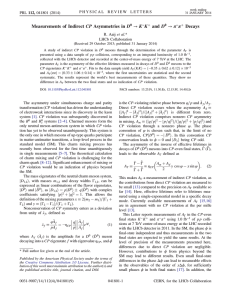
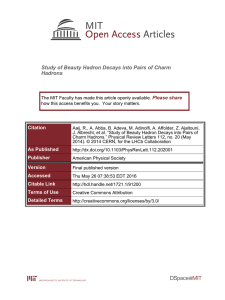
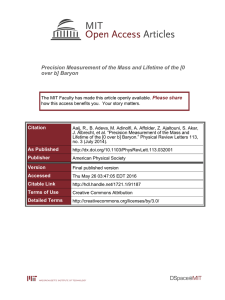
![Measurement of CP Violation in B[superscript 0] J/K[0 Please share](http://s2.studylib.net/store/data/011580922_1-5d47531893916d44d50f2a7784c4ad8b-300x300.png)
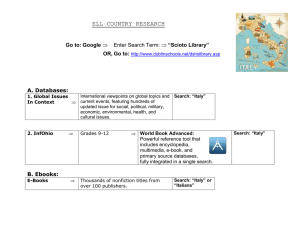

![First observation of the rare B[superscript +] Please share](http://s2.studylib.net/store/data/011609249_1-dcc1132b90e4f58e67227ac0be5159df-300x300.png)
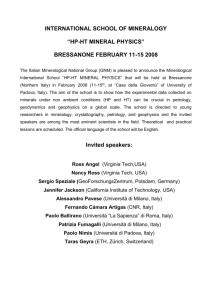
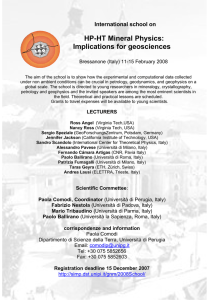
![Measurement of the CP Asymmetry in B[superscript +]](http://s2.studylib.net/store/data/012077003_1-869242bdfbbe047171b4e088f864021d-300x300.png)
![Test of Lepton Universality Using B[superscript +]](http://s2.studylib.net/store/data/012653314_1-f98644458643d6691ea1413e783b901a-300x300.png)
![Observation of the decay [bar over B][0 over s] Please share](http://s2.studylib.net/store/data/012412564_1-63ccb2fdb0162a764f29b31ac22af78c-300x300.png)